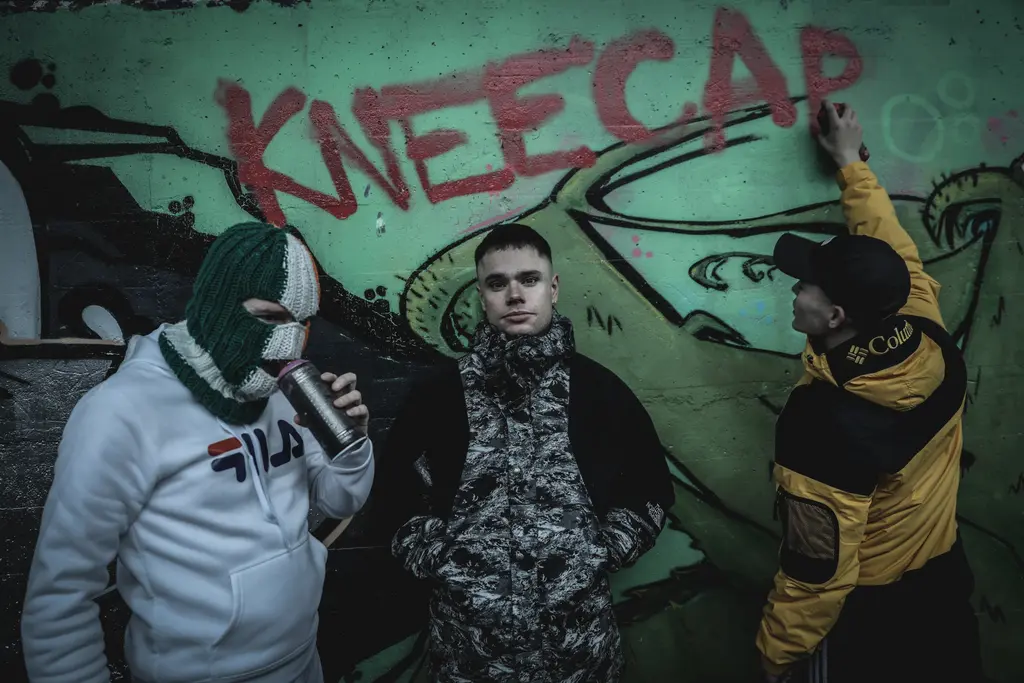SAMO® mastermind Al Diaz on the evolution of NYC graffiti
- Text by Miss Rosen
- Photography by Charlie Ahearn (main image)

Possessed of an inimitable blend of candour and charm, artist Al Diaz embodies New York cool. Growing up on the Lower East Side, Diaz became one of the earliest graffiti writers in the community.
“I was known in the Jacob Riis Houses as the kid who writes on the wall. Being a writer was an identity, like being a skater, an athlete, or a punk kid,” says Diaz, who started writing in 1971 at the tender age of 12.
His passion to tag quickly grew into an obsession. By the time Diaz entered the High School of Art & Design in 1973, he was writing “BOMB ONE” (his moniker) on the streets and trains. He soon discovered that graffiti crossed socioeconomic barriers in New York and became friends with people he might never otherwise encounter in his neighbourhood.
But as Diaz grew older, the clandestine scene of his early teens began to shift. “What was initially so attractive about graffiti was that it had a sense of a secret organisation, an ‘us and them’ kind of thing,” he says. “By 1976, a lot more people were involve and it was a little more pedestrian.”

Lee with horse by Charlie Ahearn
That same year, Diaz transferred to City-As-A-School in Brooklyn and met Jean-Michel Basquiat at a mutual friend’s house. They became friends and together they created SAMO®. Unlike graffiti, which was a coded conversation among writers occurring in a public space, SAMO® was envisioned as clear, legible messages to any person walking down the street.
The art world quickly took notice of the writing on the wall. Basquiat’s star shot into the stratosphere while Diaz stayed close to the culture of his roots – which he recently honoured with the two-part exhibition, City of Kings at Howl! Happening and Howl! Arts/Howl! Archive in New York.

Original Soup Train by Charlie Ahearn
Diaz has teamed up with graffiti archivist and artist Eric ‘DEAL CIA’ Felisbret and art educator Mariah Fox to create an exhibition that brings together stories, photos, videos, documentaries, and ephemera from legends like CoCo 144, Taki 183, Crash, LEE, Charlie Ahearn, FLINT, and Martha Cooper, along with lesser known artists whose contributions have shaped its evolution over the years.
City of Kings provides a visual timeline illustrating the flow of ideas amid the larger history of New York, exploring the interplay of politics, economics, and environment on young artists motivated by something greater than financial reward.

By Flint Gennari
“Graffiti is about the spirit of defiance,” says Diaz, who still carries a marker. “It’s not like you stop doing it, but it’s no longer a 24/7 obsession where my jeans are covered with ink. That’s who we were and hopefully it dissipates.”
But as Diaz points out the only writers who truly quit are the people who leave the community, never to return. Most old timers regularly show up to celebrate the culture they built from the ground up.
“The beautiful thing is that New York City graffiti is an actual community,” Diaz says. “We have social media groups and everybody’s got everybody’s number. If you need to get in touch with somebody, it’s just two degrees of separation.”

By Flint Gennari

Zeph writes heroin by Charlie Ahearn

Cold Crush Tamori show by Charlie Ahern

5 Pointz 2008

Wild Style in Bx by Charlie Ahearn

By Flint Gennari
City of Kings is on at Howl! Arts/Howl! Archive: December 3 – January 29, 2023 (250 Bowery Second Floor, New York).
Enjoyed this article? Like Huck on Facebook or follow us on Twitter and Instagram.
Latest on Huck

Inside Kashmir’s growing youth tattoo movement
Catharsis in ink — Despite being forbidden under Islam, a wave of tattoo shops are springing up in India-administered Kashmir. Saqib Mugloo spoke to those on both ends of the needle.
Written by: Saqib Mugloo

The forgotten women’s football film banned in Brazil
Onda Nova — With cross-dressing footballers, lesbian sex and the dawn of women’s football, the cult movie was first released in 1983, before being censored by the country’s military dictatorship. Now restored and re-released, it’s being shown in London at this year’s BFI Flare film festival.
Written by: Jake Hall

In the dressing room with the 20th century’s greatest musicians
Backstage 1977-2000 — As a photographer for NME, David Corio spent two decades lounging behind the scenes with the world’s biggest music stars. A new photobook revisits his archive of candid portraits.
Written by: Miss Rosen

In Queens, local surfers are moulding a neighbourhood in their own renegade images
Rockaway breaks — On a little-known stretch of beach in eastern New York City, an ecosystem of wave catchers, and the local bars and restaurants that fuel them, is seeing a boom. Paolo Bicchieri meets the residents and business owners behind the growing swell.
Written by: Paolo Bicchieri

Kneecap describe atrocities in Gaza as “medieval type slaughter” after breaking of ceasefire
Saoirse Don Phalaistín — The Irish rap trio took to X yesterday to criticise the “US-backed” Israeli authorities.
Written by: Isaac Muk

Capturing joy and resilience in Istanbul through tumultuous times
Flowers in Concrete — As protests break out across Istanbul, photographer Sıla Yalazan reflects on the 2013 Gezi Park movement, and capturing beauty as the city has undergone economic change and political tension.
Written by: Isaac Muk